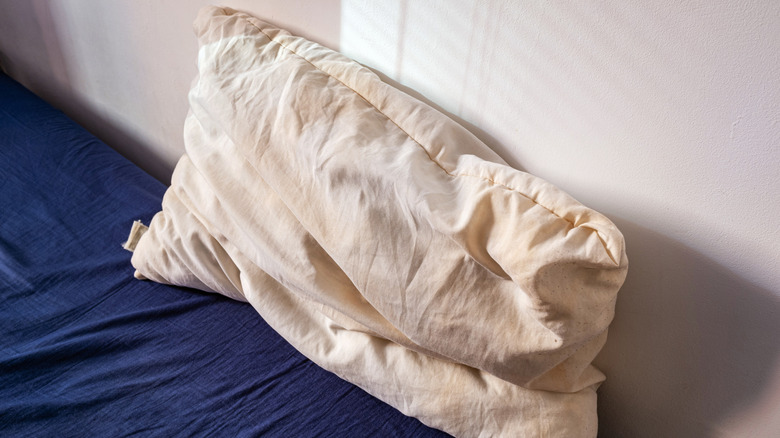Think Your Pillows Are Fine? Here's How Often You Should Actually Replace Them
We may receive a commission on purchases made from links.
Sleep is in integral part of health — and our time, since we spend a third of our lives doing it. Your pillow can be a major contributor to the quality of your sleep, affecting everything from your sleeping posture to your breathing. Pillows don't last forever, though, and you might be noticing changes in the bedding essential as time goes on. These changes will make you wonder if — and when — your pillow needs a replacement. Since finding a good pillow that meets your needs can be difficult and expensive, many people put off buying a new one until the old pillow is wafer thin and offers the same lumbar support as a sheet of paper.
Though the pillow's lifespan is determined by the materials it is made of, most should be replaced after around two years. A fresh pillow is a bedroom essential that holds the key to a good night's sleep. It even helps ease issues such as asthma, allergies, and acne, as a pillows can accumulate dander, dust mites, and mold.
Signs your pillow needs replacing
Though replacing your pillow every two years is a good standard, there are also signs you can look for to see if your pillow needs replacing. The first indicator that your pillow is not doing its job anymore is usually neck or shoulder pain. If you wake up with regular pain in these areas, your pillow has likely lost some of its firmness and is no longer providing adequate lumbar support. Another indicator is the pillow's shape. Lumpiness or flatness are reliable signs that the pillow is starting to lose its firmness. If your pillow begins to smell musty, you should probably exchange it for a fresh one, as this can be a sign of mold buildup that can't be resolved by washing.
To determine for sure if your pillow should be shown the door, use the "shoe test" developed by Dr. Michael Breus. Fold your pillow in half and place a shoe on the back. When you release the pillow, it should snap back to its original shape and fling the shoe off. If it does not, the pillow is no longer reliable. The pillow might not be a good choice for your sleeping needs, but don't toss it, because there are ways to repurpose old pillows in your home and garden.
How to increase a pillow's lifespan
For those who want to get the most out of their pillows, following proper care guidelines can help increase the pillow's lifespan and effectiveness. Down, polyester, and down alternative pillows can be machine washed in cold water on a gentle cycle, making sure not to stuff the machine full. Make sure the pillows are thoroughly dried in a dryer or air dried, as any moisture can encourage mold buildup. Latex, polyfoam, and memory foam pillows should never be washed in a machine, but they can be spot treated if necessary and laid out to air dry.
Keep dust mites and allergens at bay by using a pillow cover like the AllerEase Pillow Protectors, which keep the pillows from being penetrated by particles. For general cleanliness, wash your pillowcases — and your sheets — once a week. Also, check out these washer-free tricks to clean and freshen pillows.


